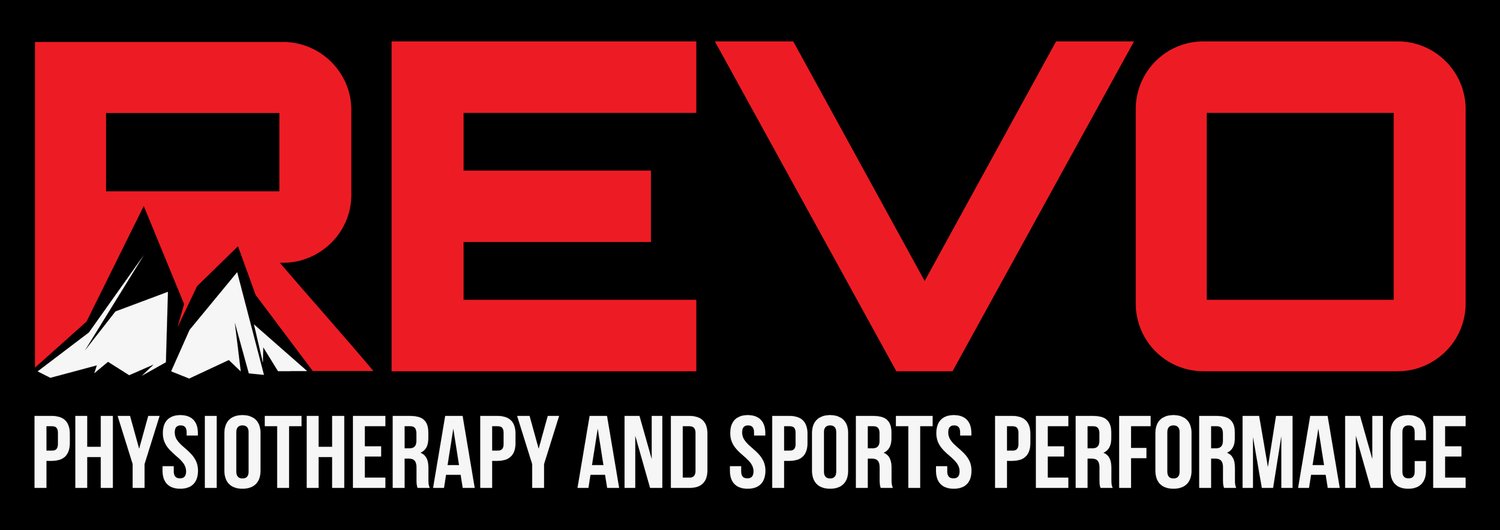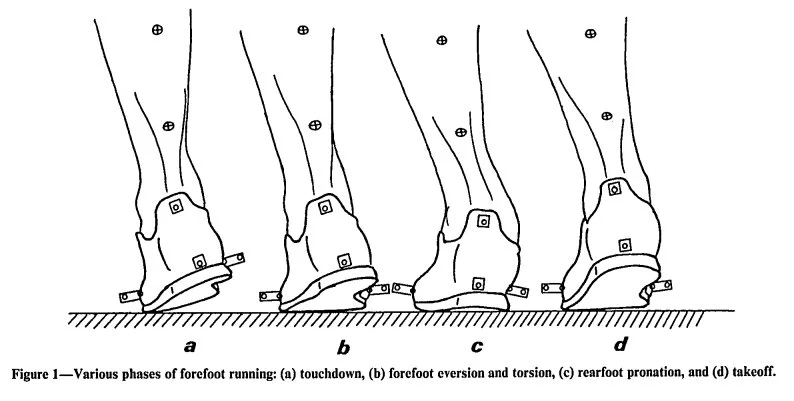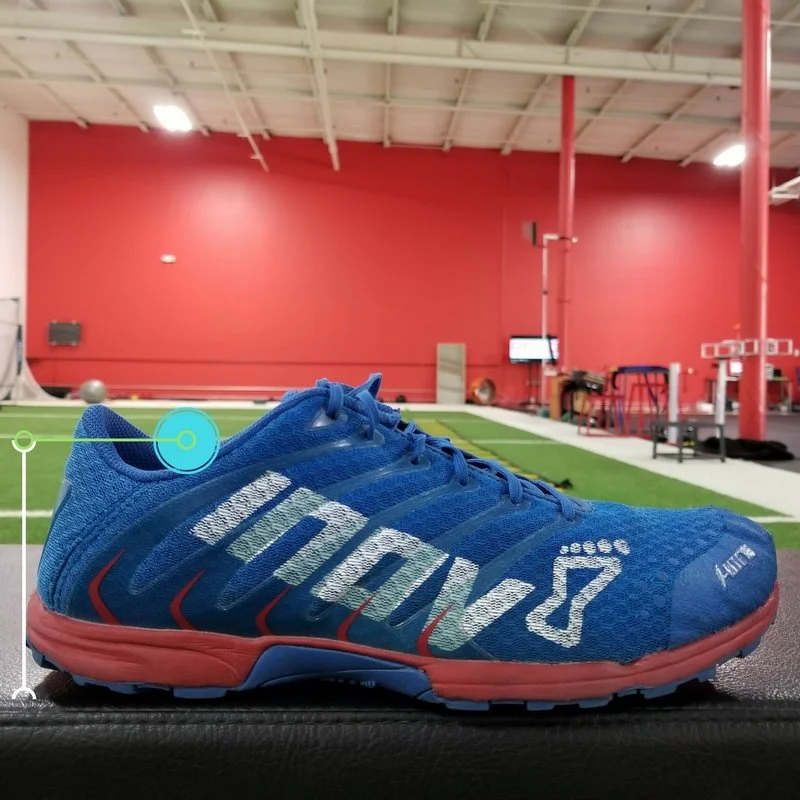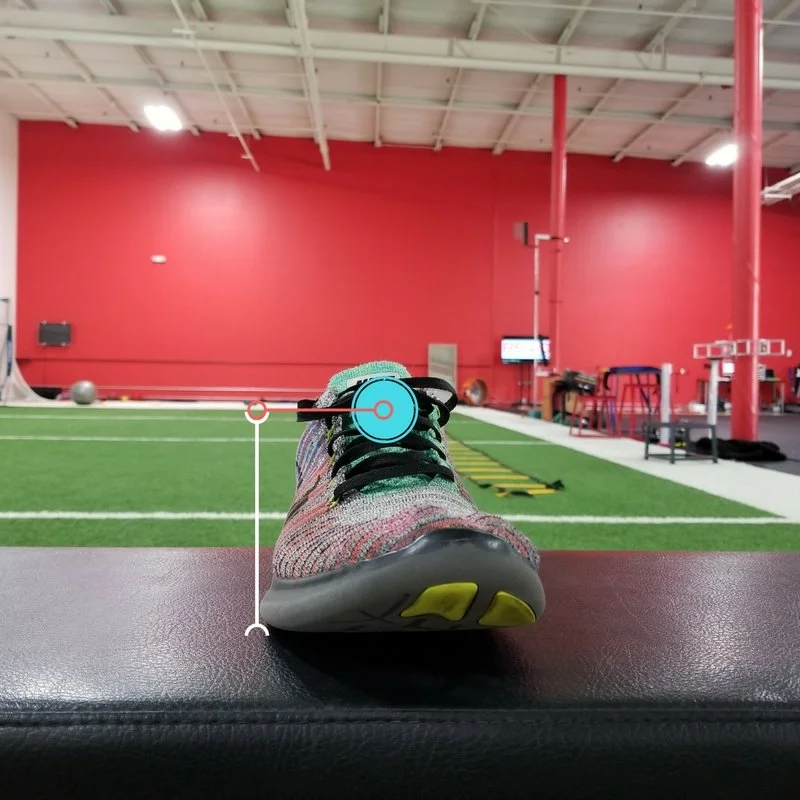Influence of shoe flaring on foot and ankle mechanics for runners.
Footwear choice for runners will forever be a hot topic. Cushioned, minimal, motion control, zero drop, the choices are endless. What really matters when it comes to footwear selection for runners?
Based on your foot strike pattern I see a few design factors that really make a difference in reducing stresses on the foot and ankle, especially pronation forces. Before we talk about design choice let's discuss mechanics of the foot and ankle during a heel strike and a forefoot strike. Without understanding normal mechanics of the foot and ankle the "why" of shoe selection won't make much sense.
Let's start with the heel strike pattern. The hallmark of this pattern is, of course, the heel contacting the ground first. Normally the first point of contact is the lateral heel, placing the foot in a slightly dorsiflexed position. From here the foot in eccentrically lowered toward the ground as the entire sole touches the ground. This eccentric muscle control is performed primarily by the anterior tibialis muscle. As this occurs the foot is also moving into pronation as a way to absorb impact forces and deal with uneven terrain. Pronation is both normal and necessary for weight acceptance in the gait cycle. Posterior tibialis, located on the posterior and medial side of the shin eccentrically controls pronation. An eccentric muscle contraction is when the muscle is contracting but also lengthening. A concentric contraction is when the muscle contracts while shortening. Eccentric contractions generally more "work" than a concentric contraction. Think of walking down a mountain and how much your quads are working during that activity vs waling up. As you more into the push off phase your center of mass is advancing over your support limb and the foot and ankle begin to move back toward a supinated position as the foot becomes a rigid lever for push off.
In the video above you will notice the runner obviously impacting the heel with the lateral portion first. There is not excessive pronation in this case but you can see some mild pronation as the foot is moved under the center of mass. It takes quite a lot of eccentric work to move into pronation in a controlled manner.
Onto the the forefoot strike pattern. The initial point of contact here is the lateral forefoot. Following initial contact, the foot and ankle are moving into pronation almost immediately. In addition to posterior tibialis controlling pronation, gastroc and soleus are also very active in controlling eccentric dorsiflexion or slowly lowering the heel to the ground. Again, pronation here is normal but excessive amounts can be problematic. Often times we focus too much on the degree of pronation and forget to address the velocity of the movement. Velocity is a key component here.
SOURCE: Stacoff A, Kalen X and Stussi E. The effects of shoes on the torsion and rearfoot motion in running. Med Sci Sports Exer, 1991; 23(4):482-490.
In the forefoot strike video above you can see an aggressive supinated position at initial contact, meaning the outside of the forefoot impacts first. Compared to the heel strike video there is further excursion into pronation as well as increased velocity. The velocity here increases the demand on the musculature controlling this movement.
Now that we have the basics of each foot strike pattern out of the way, lets discuss shoe design. My primary focus here is on flaring of the outsole of the shoe. Flaring is when the outsole extends beyond the upper either laterally or posteriorly.
For the heel striker flaring of the heel of the shoe laterally and posteriorly is not ideal. This flaring will create a longer lever arm for the anterior and posterior tibialis to control as you eccentrically pronate and bring the forefoot into contact with the ground. Height of the outsole of the shoes also plays a role here for heel strikers. Increasing the height of the heel off the ground also increases the lever arm for anterior and poster tib to control. For runners that are known heel strikers, I would highly recommend footwear that reduces the height of your heel from the ground and also has very small posterior and lateral flaring at the heel so we can reduce these lever arms as much as we can.
This is an example of a small posterior flare shoe. The outsole does not extend very far beyond the heel itself.
This is an example of a moderate posterior flare. You will notice the extra material moving behind the heel. The further posterior this flare travels the harder your anterior tibialis and posterior tibialis will have to work to eccentrically lower your foot into a pronated position.
Here we see a small lateral flare on the R vs a large lateral flare on the L. As the heel striker impacts on the lateral side of the foot, the further the impact site is from the axis the greater the lever arm. With more work required to control a longer lever arm we could see overuse like symptoms with additional training volume for some athletes. This image also shows the heel height difference in these shoes. The higher the heel is from the ground the harder it will be to move from heel strike to foot flat.
Let's not forget you forefoot and midfoot strikers. I absolutely care about flaring for you guys, but I can more about the lateral flaring near the toe box. Since forefoot strikers are contacting the ground with the outside of the forefoot a larger lateral flare is going to cause quite a change in lever arm length.
Pictured is a small lateral forefoot flare. This reducing the lever arm to the axis as much as possible.
Here we see a larger lateral flare. The increased distance from the ankle increases the lever arm and work required as the foot moves into pronation. Remember from the video above that the forefoot strike commonly sees more velocity as a runner moves into pronation. Velocity + more work required to control a movement = over stress for a lot of us.
Fore forefoot and midfoot strikers I would recommend shoes that have a very small lateral flare at the forefoot. This will allow for some energy savings in the eccentric control department.
Have you found the flaring of your shoes to be a part of any foot and ankle pain? What characteristics do you look for in a running shoe?






